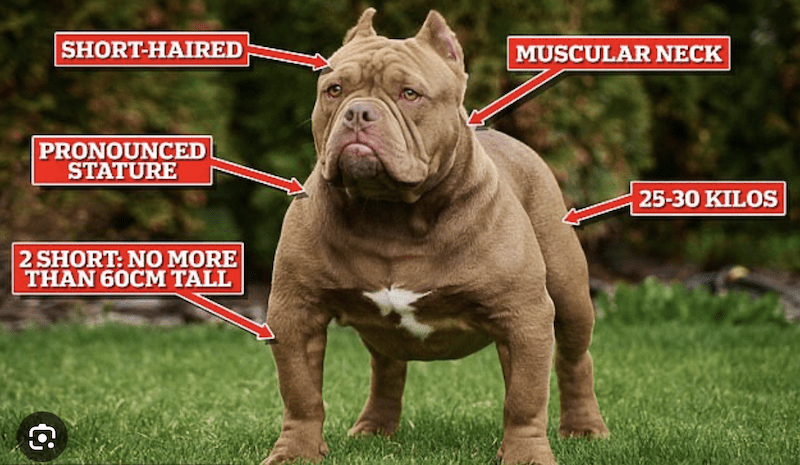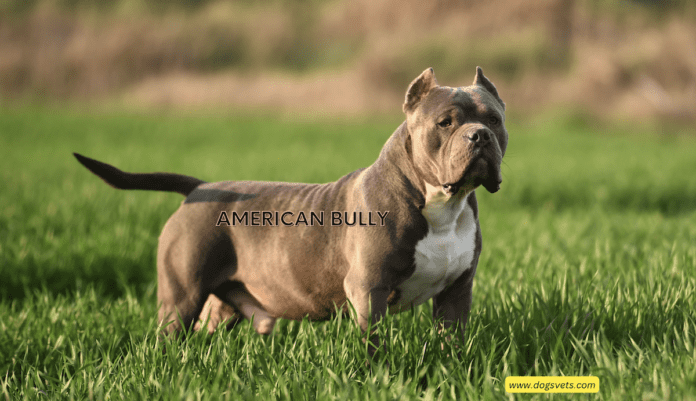Last Updated on January 4, 2024 by Dogs Vets
The Oldest American Bully: A Comprehensive Guide to Canine Longevity
Forget about Methuselah. There’s a new old-timer in town, and he’s got four paws, a wagging tail, and a heart filled with Bully love.
Yes, we’re talking about the American Bully, a breed renowned for its gentle nature, playful spirit, and, as it turns out, an impressive knack for defying the sands of time.

But just how old can these lovable lugs get? And what secrets do they hold to unlocking the fountain of puppyhood? Buckle up, dog lovers, because we’re about to embark on a journey into the extraordinary world of the oldest American Bullies.
A Breed Built to Last
Before we delve into the geriatric gang of American Bullies, let’s first understand the foundation of their longevity.
American Bullies, a relatively young breed established in the late 1980s, were meticulously crafted by crossing American Staffordshire Terriers, Bulldogs, and other sturdy breeds. This carefully curated lineage gifted them with:
- Robust health: American Bullies boast a strong immune system and are generally free from major genetic health concerns.
- Athletic prowess: Their muscular build and playful nature encourage regular exercise, a key factor in a long and healthy life.
- Gentle disposition: Less prone to stress and anxiety than some breeds, American Bullies exude a laid-back, “go-with-the-flow” attitude, which can positively impact their well-being.
Meet the Geriatric Gems
Now, let’s meet the true stars of the show – the oldest American Bullies ever recorded.
These canine Methuselahs are living testaments to the breed’s incredible potential for a long and fulfilling life:
- Junior: Hailing from New Jersey, Junior holds the official title of the oldest American Bully, clocking in at a sprightly 21 years and 5 months! This gentle giant, despite some age-related hearing loss, enjoyed his days surrounded by loved ones and belly rubs.
- Tess: This Florida resident wasn’t far behind, reaching an impressive 20 years and 10 months before crossing the rainbow bridge. Tess, known for her infectious smile and love of car rides, lived a life full of tail wags and belly flops.
- Stella: Proving that size doesn’t matter, Stella, a pocket-sized Pocket Bully from Texas, lived a whopping 20 years and 2 months. This pint-sized dynamo was a testament to the resilience and zest for life found within the American Bully breed.
Unlocking the Secrets of Longevity
So, what exactly is the secret sauce behind these phenomenal lifespans? While genetics play a crucial role, it’s a holistic approach that truly unlocks the magic:
- Diet: Feeding your American Bully a high-quality, age-appropriate diet rich in protein and essential nutrients lays the foundation for good health and longevity. Remember, consult your veterinarian for personalized dietary guidance.
- Exercise: Regular physical activity, tailored to your Bully’s age and fitness level, keeps their bodies and minds stimulated. Think brisk walks, playful fetch sessions, and even doggy swimming sessions for the adventurous souls.
- Veterinary care: Preventive care through regular checkups, vaccinations, and parasite control helps identify and address potential health issues early on.
- Love and TLC: Showering your American Bully with love, attention, and a supportive environment can work wonders for their emotional well-being, which often translates to physical health benefits as well.
Living Life to the Fullest with your Senior Bully
As your beloved Bully enters their golden years, adjustments might be necessary to ensure their continued comfort and quality of life.
Here are some tips to keep in mind:
- Adapt their exercise routine: Shorter walks, gentle swims, and indoor playtime can replace strenuous activities.
- Provide orthopedic support: Supportive bedding, ramps, and even doggy wheelchairs can help with mobility issues.
- Monitor their diet: Opt for easily digestible food and adjust portion sizes as needed.
- Shower them with extra love: Patience, understanding, and plenty of cuddles are essential for senior Bullies.
Remember, with proper care and attention, your American Bully can enjoy a long and fulfilling life, enriching your home with unconditional love and furry companionship every step of the way.
5 Most Asked Questions About American Bullies:
The American Bully, with its muscular build and playful demeanor, has become a popular breed in recent years.
But their unique appearance and sometimes misunderstood temperament often lead to curiosity and questions.
1. Are American Bullies dangerous?
Despite their muscular physique, American Bullies are generally known for their gentle and loving nature, especially towards children. They were specifically bred to be friendly companions, and with proper socialization and training, they can make wonderful family pets.
However, like any dog, it’s important to remember that any breed can exhibit aggression if not properly trained or socialized.
Responsible ownership, including consistent training and positive reinforcement, is key to ensuring any dog’s good behavior.
2. How much exercise do American Bullies need?
American Bullies are moderately active dogs and require regular exercise to stay happy and healthy. Aim for at least 30 minutes of daily exercise, which can include walks, playtime, swimming, or even dog sports like agility.
They are intelligent and thrive on mental stimulation as well, so incorporating training sessions and interactive toys can keep them engaged.
Remember, their exercise needs may vary depending on their age, health, and size (Pocket, Standard, Classic, or XL).
3. Are American Bullies easy to train?
American Bullies are intelligent and eager to please, making them relatively easy to train with positive reinforcement methods. They respond well to consistent commands, rewards, and patience.
Early socialization is crucial for any dog, but especially for breeds like the American Bully, to help them learn proper interaction with other dogs and people. Remember, their strong build requires a firm but gentle approach during training.
4. How much do American Bullies cost?
The cost of an American Bully puppy can vary widely depending on several factors, such as the breeder’s reputation, the puppy’s pedigree, size, and coat color.
Generally, you can expect to pay between $1,500 and $5,000 for a well-bred puppy. It’s important to do your research and choose a reputable breeder who prioritizes the health and temperament of their dogs.
5. Do American Bullies make good apartment dogs?
While American Bullies can adapt to apartment living, their size and exercise needs require careful consideration. They need sufficient space to move around and expend their energy. Regular walks and playtime are essential to prevent boredom and destructive behavior.
If you live in an apartment, ensure you can provide opportunities for your Bully to release their energy and ensure they are not disturbing neighbors with excessive barking.
Remember, every dog is an individual, and these are just general answers to common questions. Always research and choose a breed that suits your lifestyle and living situation.
With proper care, training, and love, American Bullies can be wonderful companions for families and individuals alike.
6. What is the average lifespan of an American Bully?
While official data is still evolving, American Bullies generally have a lifespan of 12-16 years. However, with proper care and attention, they can often exceed this average, as evidenced by the incredible senior Bullies we’ve met.
7. Are there any specific health concerns I should be aware of with senior American Bullies?
References:
- American Bully Club of America: https://abkcdogs.net/
- The Bullybomb of the 20th Century: https://thesmartcanine.com/what-pitbulls-bred-for/
- History of the American Bully: https://bullyblood.com/american-bully-history/

















